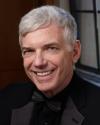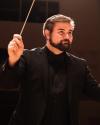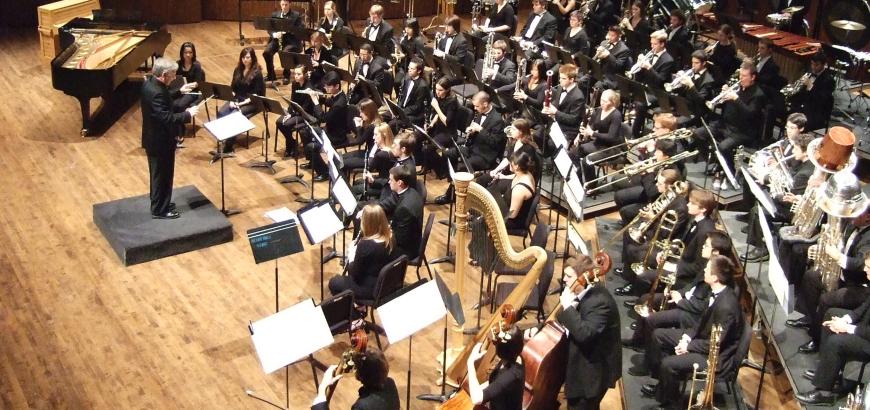The UW Wind Ensemble (Timothy Salzman, director) and Symphonic Band (Shaun Day, director) present their Autumn Quarter concert.
Masks are required in all indoor spaces on the UW campus, and patrons must show proof of vaccination or recent (within 72 hours of the performance) negative COVID-19 test for entry to live events at Meany Hall. Enhanced sanitation measures and touchless ticketing are among other safety measures in effect for 2021-22. Details of these policies and procedures are at: https://artsevents.washington.edu/covid-protocols
Program
Wind Ensemble Trumpets
Dürrenhorn Passage - Kevin McKee (b. 1980)
Wind Ensemble Trumpets: Carlos Alvarez, Jennifer Stump, Zach Griffin, Colton Lindstrand, Brandon Cain, Caroline Kelly
University of Washington Symphonic Band
Shaun Day, director
Canzon Noni Toni – Giovanni Gabrieli (1554-1612) ed. Robert King
Brass Choir
Dream Forest (2014/17) – Yosuke Fukuda (b. 1975)
Woodwind Choir & Percussion
Dancer in the Dark (2000) – Björk Guðmundsdóttir (b. 1965)
Brass Choir & Percussion
Cotswolds Pictures (2010/10) – Hayato Hirose (b. 1974)
Woodwind Choir
Chorale and Alleluia (1954) – Howard Hanson (1896-1981)
Pastime with Good Company – King Henry VIII (1491-1547) arr. Philip Sparke
University of Washington Wind Ensemble
Timothy Salzman, director
Introduction et Variations Sur Une Ronde Populaire (1934) – Gabriel Pierné (1863 - 1937)
University of Washington Wind Ensemble saxophones
Ascent (2020) – Alex Shapiro (b. 1962)
Lux Perpetua (2020) – Frank Ticheli (b. 1958)
Symphony No. 3 ‘Slavyanskaya’ (1950/1995) – Boris Kozhevnikov (1906-1985) (ed. Bourgeois)
I. Allegro, decisively
II. Tempo of a slow waltz
III. Vivace
IV. Moderato, joyously
Shaun Day, conductor
Roger Wu Fu, conductor
Corey Jahlas, conductor
Program Notes
Dürrenhorn Passage was composed by Kevin McKee was written for six trumpets and was commissioned by Dr. James Zingara and the Troy University trumpet ensemble. Dürrenhorn Passage depicts the flight of an epic alpine landscape brought forth by a development of motor rhythms and soaring melodic themes.
Giovanni Gabrieli was an Italian composer during the Renaissance in the 16th-17th century. His influential compositional style spread throughout Europe with his antiphonal textures, polychordal writing, and introduction to written dynamics. As instruments began taking the place of vocal compositions, Gabrieli published his first collection of works we refer to as Sacrae Symphoniae, consisting of 45 vocal works and 16 instrumental works. Canzon Noni Toniwas first published as part of that collection.
Yosuke Fukuda is a Japanese composer and oboist who has helped expand the music research in multimedia compositions from the 90’s. Dream Forest is a programmatic work that depicts what one may hear or encounter while wandering in a forest. The development of mysterious chords and musical motifs were created by members of the NAKAMURA Dai-ichi Junior High School Band, whom this work was commissioned by.
Björk Guðmundsdóttir is an Icelandic experimental songwriter and singer. Throughout her career she pursued a solo career and in 1999 she was asked to write and produce the musical score for the film Dancer in the Dark, where she also played the lead role. This arrangement of the overture to Dancer in the Dark develops from an open pedal note to layers of a melancholic brass chorale.
Hayato Hirose is an active composer and conductor at the Shobi Music College in Tokyo, Japan. From the late 90’s to today he is credited with composing many adaptable works for winds. Cotswolds Pictures depicts his experience visiting the Cotswolds region in the suburbs of London, England, visualizing the rural landscapes during the harvest season.
Howard Hanson was a main contributor to the American musical world in the early-mid 20th century as an educator, composer, and conductor. Chorale and Alleluia was Hanson’s first work for a wind ensemble, at a time when wind ensembles were becoming well established. This work transitions from a flowing choral to a joyous theme that is pleasantly resonant.
While King Henry VIII is mainly known for his monarch rule in 15th-16th century England, he also is credited with several compositions. Pastime with Good Company is his best-known work and was composed while he was still a prince. The themes depict the joys of dancing and singing and would typically be sung as part of the court entertainment.
Gabriel Pierne was a French composer, pianist, and organist who wrote a great number of works for chamber ensembles as well as larger orchestral and band ensembles. Introduction et Variations Sur Une Ronde Populaire was dedicated to the Marcel Mule saxophone quartet, and it since has been established as standard saxophone repertoire. The piece begins slowly with many colorful and interwoven melodic ideas which are then interrupted multiple times by the jaunty and childlike rondo theme. That theme is then developed and expanded in various ways before ending in a triumphant climax.
Alex Shapiro was born in New York City and was educated at the Juilliard School and Manhattan School of Music as a student of Ursula Mamlok and John Corigliano. The majority of her catalog is chamber works, and since 2008 she has also composed several commissions for symphonic wind band, several of which include the use of prerecorded electronics. Shapiro is an active participant in the U.S. art music community. She currently serves on the board of directors of the American Music Center and the MacDowell Colony and sits on the ASCAP Symphony & Concert Committee; in 2010 she was elected as the concert music composer representative to the ASCAP Board of Review. She is the recent president of the board of directors of The American Composers Forum of Los Angeles and Moderator of the Los Angeles Composers Salon series from 2000 to the present, for which she has interviewed over 100 composers. Shapiro testified in September 2009 on a Federal Communications Commission panel hearing in Washington, D.C., about broadband access and digital rights issues. Shapiro served on the board of directors of the American Civil Liberties Union of Southern California from 1990 to 1996, including a term as the 30,000-member affiliate's vice president. She is the recipient of three awards from the ACLU honoring her activism, including being named the 1993 Chapter Activist of the Year.
Ascent reflects the effort to get off the ground, literally or figuratively. It's a micro-overture that begins with the promise of upward transcendence, yet soon flies off into rogue disorganization. The raucous flock of many notes finally gathers into a united upward-headed murmuration, but the freedom of soaring into the sky brings an uneasy mystery before settling into the tranquil air of anticipation. Ascent was commissioned by Jeffrey Boeckman and the University of Hawai'i at Manoa, with the participation of the University of Washington and 23 other commissioning institutions.
- Program Note by composer
Frank Ticheli joined the faculty of the University of Southern California's Thornton School of Music in 1991, where he is Professor of Composition. He is well-known for his works for concert band, many of which have become standards in the repertoire. In addition to composing, he has appeared as guest conductor of his music at Carnegie Hall, at many American universities and music festivals, and in cities throughout the world. Frank Ticheli is the winner of numerous composition awards including the 2006 NBA/William D. Revelli Memorial Band Composition Contest, the Charles Ives and the Goddard Lieberson Awards, both from the American Academy of Arts and Letters, the Walter Beeler Memorial Prize, and First Prize awards in the Texas Sesquicentennial Orchestral Composition Competition, Britten-on-the-Bay Choral Composition Contest, and Virginia CBDNA Symposium for New Band Music.
Lux Perpetua was composed for the Baylor University Wind Ensemble in memory of two young clarinetist members of that ensemble, Laura Onwudinanti and Jack Stewart, whose lives were tragically cut short in an automobile accident in 2014. The work’s title is drawn from the last line of the Latin text, Lux aeterna: “et lux perpetua luceat eis” ("and let perpetual light shine upon them"). The idea of light as both protector and illuminator was constantly in my mind as I composed the piece. Two kinds of light comprise the work: one soft and meditative, the other more sparkling and effervescent. Also in mind were the respective personality traits of the two dedicatees, Jack being more thoughtful and introspective, Laura being more spontaneous and gregarious.
A simple call motive begins the piece, introduced by the clarinets. Its two main notes form a descending minor 3rd, a sound that is universally associated with a call or greeting (think “yoo-hoo”) but also widely associated with playground games and nursery rhymes. This idea is laced into the entire fabric of the piece, sometimes serving as transition material, other times appearing unexpectedly for purposes of contrast, still other times flowering into main melody.
The main melody is at once longing and noble in quality and is constructed in a way that suggests the notion of infinity. Its accompanying harmony depicts a kind of bellows or the act of breathing, in and out perpetually. It never settles on a final chord, but instead moves to a built-in modulation, compelling the melody to repeat itself in a chain of new keys.
A faster, more energetic middle section serves as a dramatic contrast, but rather than give it a new theme, I chose to continue with a variant of the main melody. The accompanying harmony is still breathing, the lyrical line still permeating the entire section, but this time building to a tremendous climax. The final coda is a brief meditation. The main melody echoes itself tenderly as the harmony begins its slow and fragile ascent to the heavens.
Lux Perpetua received its world premiere by the Baylor University Wind Ensemble, Eric Wilson, conductor, at the centennial meeting of the Texas Music Educators Association on February 13, 2020.
- Program Note by composer
Legend would tell us that the United States Marine Band (“The President’s Own”) performed a feat of great espionage upon their return home from the Soviet Union in 1990. As the military tells us, “Combining music of Sousa with images of Lenin, the Marine Band toured five cities in the former Soviet Union, becoming the only American military band to tour the USSR before its transformation into independent states.” The tour generated a bounty of propaganda during the waning months of the Cold War.
What we did not learn about until years later was the wealth of Russian band music discovered by the Marine Band musicians while on tour and, as some would tell, smuggled into the United States upon the band’s return home. Boris Kozhevnikov’s Slavyanskaya Symphony is one of a handful of contraband works heretofore never heard in the Western world until the fall of the Iron Curtain. Although composed in the late 1950s, the compositional style is pure Classicism colored with Romantic sentimentality; the symphony reflects the ideals of Socialist Realism. The conservative compositional language provides evidence that Boris Kozhevnikov, a Soviet-era bandmaster and conservatory professor, was equally savvy in playing Communist politics as he composed music that was conservative enough for the censors, yet zestfully Slavic and (perhaps subversively) nationalistic.
The work is a four-movement symphony with heavy Russian musical atmosphere and includes the quotation of folk tunes that Kozhevnikov learned in his hometown of Novgorod. The name Slavyanskaya does not have a set meaning as it is a common name – a town square in Moscow as well as a Russian vodka company – and it is unclear where Kozhevnikov acquired the inspiration for the title. The first movement is a mix of militaristic, aggressive and lyrical playing by the ensemble. The second movement is a slow waltz ending in a stirring coda leading to the third movement rondo that moves at lightning speed. The final movement is an exhilarating finale, recalling the militaristic themes and styles of the other movements.
- Program note by Lawrence Stifle
Personnel
UNIVERSITY OF WASHIINGTON SYMPHONIC BAND
FLUTE
Callum McCubbin, Junior, Physics, Pullman
Bethany Quevedo, Issaquah
Shelly Shen, Freshman, Music, Shanghai, China
Max Williams, Senior, Music Composition/Mathematics, Issaquah
Yue Zhong, Freshman, Pre-Sci & Music, Blacksburg, VA & Shanghai, China
OBOE
Marrakesh Beaner, Freshman, Anthropology, Fort Collins, CO
Cloe Coker, Freshman, Microbiology, Richland WA
CLARINET
Richard Li, Grad, Computer Science, Greenville SC
Jason Liu, Junior, Undeclared, Camas
Raul Arturo Robles, Junior, Medical Laboratory Sciences, Prosser WA
David Wang, Sophomore, Undeclared, Taipei Taiwan
BASSOON
Nate Chen, Sophomore, Computer Science, Vancouver
SAXOPHONE
Ashley Grinstead, Junior, Chemical Engineering, Bellingham
Zihan Lin, Junior, Computer Science & Music, Irvine CA
Reis Pestano, Freshman, Engineering Undeclared, Lafayette CO
Mikey Prince, Senior, Music Education & Gender, Women, and Sexuality Studies, Kirkland
TRUMPET
Carter Archuleta, Junior, Physics and Astronomy, Gig Harbor
Brandon Cain, Senior, Music Education & ELS Minor, Spanaway
Nathaniel Gniffke, Junior, Music Education, Shoreline
Riley Huston, Junior, Industrial Design, Kirkland
HORN
Jacob Angerman, Junior, Electrical Engineering, San Antonio TX
Sydney Kuhl, Sophomore, Computer Engineering, Prior Lake MN
Noelani Yonahara Stewart, Freshman, Political Science and American Ethnic Studies, San Francisco CA
TROMBONE
Dion Archer-Roll, Freshman, Physics, Vancouver
Peter Lin, Sophomore, ACMS, Seattle
Duncan Weiner, Sophomore, AA, Seattle
EUPHONIUM
Ivan Nolasco Hernandez, Grad, Music Education, Los Angeles CA
TUBA
Keanu Vestil, Grad, Computer Science, Rancho Santa Margarita CA
PERCUSSION
Lily Gibbs, Junior, Math & Astronomy, Kirkland
Billie Reafs, Sophomore, Music, Reno NV
Sarah Quach, Sophomore, Psychology B.S., Huntington Beach CA
UNIVERSITY OF WASHINGTON WIND ENSEMBLE
FLUTE
Tracia Pan, Fr., Music Performance, Bellevue*
Elizabeth Nilles, So., Music Performance/Biology, Camas
Stephanie Chuang, Sr., Computer Science/Cinema and Media Studies, Camas
Carson Chadd, Fr., Music Performance, Marysville
OBOE
Daren Weissfisch, Grad., Orchestral Conducting, Ridgewood, NJ*
Kamill Tarnawczyk, Sr., Physics/Music, Edmonds
Oliver Wang, Jr., undeclared, Hangzhou, Zhejiang, China
BASSOON
Julien Tsang, Grad., Accounting, Kent*
Chloe Person, So., Music History, Kenmore
Nate Chen, So., Computer Science, Vancouver
CLARINET
Khang Zhie Phoong, Sr., Computer Science, Singapore*
Alex Gee, Fr., undeclared, Camas
Conrad Lin, So., Statistics, Boise, ID
Megan Rideout Redeker, Jr., Music Performance, Bainbridge Island
Tyler Roberts, Post Bac., Music Education, Redmond
Mina Hung, Jr., Art & Food System, Nutrition, and Health, Taipei, Taiwan
BASS CLARINET
Emerson Bowles, Jr., Physics, San Diego, CA
SAXOPHONE
Nicholas Franks, Jr., Music Education, Camarillo, CA*
Diego Mesquita, So., Civil Engineering, Bellingham
Lisa Dockendorff, Jr., Society, Ethics, and Human Behavior, Vernon, CT
Katie Zundel, Fr., Music Performance/Engineering, Clinton
TRUMPET
Shaun Day, Grad., Wind Conducting, Cincinnati, OH*
Zach Griffin, So., Music Performance, Bothell
Carlos Alvarez, So., undeclared, Kirkland
Caroline Kelly, Music Performance/Environmental Science, Chelan
Colton Lindstrand, So., Biology, Marysville
Brandon Cain, Jr., Music Education, Graham
Jennifer Stump, So., undeclared, Lynnwood
HORN
Anna Perry, Grad., Music Performance, Hilliard, OH*
Nicholas Hidy, Grad., Music Performance, Sebastopol, CA
Maia Willebrand, So., Aeronautics and Astronautics, Puyallup
Kiyoshi Colon, Fr., Chemistry, Everett
Aaron Anderson, Jr., Music Performance, Tigard, OR
TROMBONE
Neal Muppidi, So., Physics/Music, Austin, TX*
Sean Grimm, Sr., Statistics, Vancouver
Jonathan Elsner, Jr., Mathematics, Kent
Alberto Macias, Jr., Psychology, Yakima
Clayton Thomas, Sr., Electrical Engineering, Kenmore
EUPHONIUM
Corey Jahlas, Grad., Wind Conducting, Highland, MI
Ethan Walker, So., Music Education, Kenmore
TUBA
Ben Berlien, community member, Seattle*
Roger Wu Fu, Grad., Wind Conducting, Santiago, Chile
BASS
Beau Wood, Sr., Music Performance, Longview
PERCUSSION
Scott Farkas, Grad., Music Performance, Twin Falls, ID*
Abigail George, So., Music Performance, Redmond
Nina Okubo, So., undeclared, Yakima
Brindha Jaeger, Fr., Music Performance/Environmental Science, Stanford, CA
Simon Harty, Fr., undeclared, Boise, ID
Ryan Baker, So., Music Performance, Gig Harbor
PIANO
Yen-Chun (Kay) Yeh, Grad., Music Performance, Chaiyi, Taiwan
Cicy Li, Grad,. Music Performance, Shenzen, Guangdong, China
HARP
Kelly Guangyin Hou, So., Music Performance/Informatics, Bellevue
GRADUATE STUDENT CONDUCTORS
Shaun Day, Grad., Wind Conducting, Cincinnati, Ohio
Corey Jahlas, Grad., Wind Conducting, Highland, MI
Roger Wu Fu, Grad., Wind Conducting, Santiago, Chile
*principal
Ensemble Bios
Wind Ensemble
The University of Washington Wind Ensemble has performed at many prestigious music conventions, has presented several world premiere performances of outstanding new music for wind band and in 2004, undertook a highly acclaimed nine-day concert tour of the Kansai region of Japan, returning for more extensive tours of that country in 2007 and 2010. The UW Wind Ensemble presented several concerts in the main concert venues of Beijing, China in March of 2013, including a sold-out concert in the National Center for the Performing Arts in Tiananmen Square that was broadcast nationwide on China Central Television. The ensemble returned to China in both 2016 and 2019, playing before large crowds in Beijing, Shanghai, Xi'an and Chengdu. In the spring of 2006, the ensemble was invited by the Seattle Symphony Orchestra to present a concert at Benaroya Hall as a part of the Symphony’s Made in AmericaFestival. The London Financial Times review of the concert applauded “music of surprising sophistication…Cindy McTee’s Finish Line pulsated energetically, and William Bolcom’s Song was simply gorgeous.” Following the 2006 performance the ensemble was invited for return appearances on Seattle Symphony concert series in 2007, 2008 and, most recently in 2011 when Maestro Gerard Schwarz conducted the ensemble. The UW Wind Ensemble has collaborated with internationally renowned guest artists, conductors and composers including Eddie Daniels, Steve Houghton, Allen Vizzutti, Jeffery Fair, Chris Olka, James Walker, Douglas Yeo, Leigh Howard Stevens, David Maslanka, Michael Colgrass, Bonnie Whiting, Cindy McTee, Eric Ewazen, Satoshi Yagisawa, David Stanhope, John DiCesare, David Gordon, Mary Lynch, Seth Krimsky, Michael Brockman and Huck Hodge. Nihon Pals, a music education resource company based in Osaka, Japan, released a set of instructional DVDs regarding ensemble musicality featuring the UW Wind Ensemble.
Symphonic Band
The Symphonic Band (Shaun Day, director) is the second auditioned wind group at the University of Washington, performing a repertoire of classic and contemporary wind music. Membership is open to students from all schools and departments of the University of Washington. The Symphonic Band performs at least one on-campus concert per quarter with occasional off-campus performances.
Director Bios

University of Washington Professor Emeritus Timothy Salzman served as Professor of Music/Director of Concert Bands and conductor of the UW Wind Ensemble from 1987 to 2025. When he was appointed to the position there were 11 students enrolled in one UW wind band – in his final year there were 335 enrolled in five bands. Former graduate wind conducting students of Professor Salzman have obtained positions at 73 universities and colleges throughout the United States and include past presidents of the American Bandmasters Association and the College Band Directors National Association as well as Jiannan Cheng, Assistant Conductor of the Baltimore Symphony Orchestra. During his tenure at the UW the band program was involved in commissioning and, in certain cases, the premiering of 38 new works for wind ensemble and undertook many concert tours including seven to Asia. From 1978 to 1983 he was band director in the Herscher, Illinois, public school system where the band program received numerous state, regional and national awards in solo/ensemble, concert and marching band competition. Immediately prior to his UW appointment he served for four years as Director of Bands at Montana State University where he founded the MSU Wind Ensemble and ‘Spirit of the West’ Marching Band. Professor Salzman holds degrees from Wheaton (IL) College, and Northern Illinois University, and studied privately with world-renown wind instrument pedagogue Arnold Jacobs, former tubist of the Chicago Symphony Orchestra. He has numerous publications for bands with the C. L. Barnhouse, Arranger's Publications, Columbia Pictures, Hal Leonard Publishing and Nihon Pals publishing companies, and has served on the staff of new music reviews for The Instrumentalist magazine. Professor Salzman has been a conductor, adjudicator, arranger, or consultant for bands throughout the United States and in Canada, England, France, Russia, South Korea, Indonesia, Thailand, Singapore, the Philippines, China, and Japan, a country he has visited twenty-one times. He has traveled to China twelve times where he served as visiting professor at the China Conservatory, given master classes for numerous wind bands, and conducted several ensembles including the Shanghai Wind Orchestra, the People's Liberation Army Band, the Beijing Wind Orchestra, The China Conservatory Wind Ensemble and the Tsinghua University Band in multiple concerts. He also served on three occasions as an adjudicator for the Singapore Youth Festival National Concert Band Championships. He has conducted several of the major military bands in the United States including a 2019 world premiere with 'The President's Own' United States Marine Band. He was compiling editor and co-author (with several current and former UW graduate students) of A Composer's Insight: Thoughts, Analysis and Commentary on Contemporary Masterpieces for Wind Band, a five-volume series of books on contemporary wind band composers. The forwards to each volume were written by five Pulitzer Prize-winning composers. He was also a contributing author to a recent book (2022) about his former teacher entitled Arnold Jacobs: His Artistic and Pedagogical Legacies in the 21st Century. Professor Salzman is an elected member of the American Bandmasters Association and is a past president of the Northwest Division of the College Band Directors National Association. He is an elected member of the Drum Corps International Hall of Fame as well as the Santa Clara (CA) Vanguard and Cavaliers (IL) Drum and Bugle Corps Hall(s) of Fame for his work as an arranger and brass instructor. In 2009 Nihon Pals, a music education resource company based in Osaka, Japan, released a set of instructional DVDs regarding ensemble musicality featuring the UW Wind Ensemble. The University of Washington hosted the 2011 National Conference of the College Band Directors National Association.

As a conductor, trumpet player, and educator, Shaun Day enjoys sharing his passion by working with a variety of music ensembles and creating a positive community through music. Shaun is completing his DMA in Instrumental Conducting at the University of Washington where he is the director and conductor for the UW Symphonic Band, and the associate conductor for the UW Wind Ensemble. He is also serving as the Conductor and Artistic Director for the Mukilteo Community Orchestra and enjoys connecting with local music educators in the Seattle area. Shaun continues to work as an ensemble clinician, guest conductor, and as a presenter at music education conferences, including the Washington Music Educators Association (WMEA) State Conference.
Originally from Cincinnati, Ohio, Shaun earned his BM in Music Education with a concentration in trumpet performance, and his MM in Conducting from the University of Cincinnati, College-Conservatory of Music (CCM). During that time, he was the manager of the CCM Wind Symphony, CCM Brass Choir, the University Commencement Band, and a Graduate Assistant of the University of Cincinnati Bearcat Band. Shaun also served as the Associate Conductor of the University of Cincinnati Symphony Orchestra and Guest Conductor for the Fillmore Philharmonic Brass (OH).
Before completing his MM, Shaun was the assistant band director at Turpin High School in Cincinnati. His duties included directing the high school concert bands, directing the high school jazz program, the musical theatre pit orchestra, assisting and directing the high school marching band program, and directing the 5th-12th concert bands. His professional affiliations include the College Band Directors National Association (CBDNA), Washington Music Educators Association (WMEA), and the Ohio Music Education Association (OMEA) where he served as the District XIV Secretary and Treasurer from 2016-2018.

Originally from Highland, MI, Corey Jahlas is in his first year of the Doctor of Musical Arts and Instrumental Conducting program at the University of Washington, where he serves as a Graduate Student Conductor of the Husky Athletic Bands, co-conductor of the Campus Band, and assistant conductor of the Wind Ensemble.
Most recently, Corey earned his Master of Music in Wind Conducting from Central Michigan University, studying with Prof. Jack Williamson. There, he instructed the 280-member Chippewa Marching Band and served as the instructor on record for the Symphony Band and the University Band. Prior to his Master’s work, Corey taught from 2014-2017 in Oxford, MI, leading the middle school band program, the OMS Percussion Ensemble, and assisting with the OHS Wildcat Marching Band.
Corey also holds degrees in Music Education and Music Theory and Composition from Central Michigan, where he studied euphonium with Dr. Mark Cox and composition with Dr. David Gillingham. Sharing his love for the marching arts, Corey served as Assistant Director of the Madison Scouts Drum and Bugle Corps in 2014, having marched with the group in 2011. He also serves as a clinician, arranger, and drill writer for high schools and university marching bands in Michigan, Ohio, Pennsylvania, and New Hampshire, and is the Director of the Drum Major Camp at Central Michigan University. Corey holds memberships in the National Association for Music Education, Pi Kappa Lambda, Phi Mu Alpha Sinfonia, and Kappa Kappa Psi.

M.M Wind Conducting, Peabody Institute of the Johns Hopkins University, 2020
M.Ed. Education, Concordia University Irvine, 2018
B.A. Anthropology, University of California Los Angeles, 2014
Recent works include producing and music directing his original musical “Yappie: The Musical” and its concept album premiere, music directing chamber operas exploring the relationship between growth and suffering in Baltimore’s contemporary opera scene, and presenting research on instrument pedagogy, choice, and personality at Ohio State University. At the Peabody Institute of the Johns Hopkins University, Roger worked as a conductor, performer, teaching assistant and faculty substitute. Through summer conducting workshops, Roger has worked with conductors including Dr. Travis Cross, Dr. Mallory Thompson, Professor Charles Peltz, Dr. Cynthia Johnston Turner, Dr. Mark Scatterday, Professor Kevin McKeown and Dr. Mitchell Fennell. Drawing from his own varied background studying anthropology at the University of California, Los Angeles, and Wind Conducting at Peabody Institute of the Johns Hopkins University, Roger seeks to combine a high standard of musical performance with a rigorous academic approach, always seeking to explore and present music in a new and different light.
Outside of music, Roger works with the mental health foundation Healthy Gamer by providing peer-delivered recovery support services as a group and personal coach. In his offtime, Roger enjoys being a mediocre cook, catching up on popular shows from half a decade ago, and biking. Roger is extremely excited to join the Husky family at UW, and get to know the PNW at large - Go Dawgs!
